Interview
Interview: Ludgi Savon
Interviewing artist Ludgi Savon – Maison Novas.
Words collected and translated by Léa Franceschi.
Ludgi Savon is the visual artist from Fort-de-France, Martinique behind Maison Novas. Maison Novas explores the plurality of his themes through different medium such as painting, drawing, embroidery and sewing, video making and photography, or even performance. As the heir of the rich and cosmopolitan Martinican culture – mixing influences from Europe, Africa and Asia – the artist explores and honours the celebration of nature and mankind with poetic joy.
Read more about his journey into arts:
Hello Ludgi! Could you tell me more about your interest in arts? When did you realise you wanted to be creative? That you were an artist?
My imaginary life had always been strongly influenced by images that would echo in me. I naturally started drawing those images from a very young age. I can remember my fascination with anime like Dragon Ball Z or other Japanese cartoons characters when I was a kid. I would draw them repeatedly! This whole imaginary world from my childhood really impacted my work as an adult, as an artist. For instance I can remember those roses my grandfather was constantly taking care of in our family garden. As I started developing my work as an artist, I quickly realised that my fascination for the vegetal world was born from this vivid memory, that it was a story I had to tell: I made a performance out of it.
Did you follow an artistic formation? What are the main events that paved your path?
Well, my first ‘real’ encounter with arts was back in secondary school, maybe year nine? I went with my class on a scholar trip to Paris, and ended up visiting the Louvre Museum. It was my first time in this place. I was surrounded by masterpieces, and felt completely overwhelmed. To be honest, it kind of felt like an epiphany! After this trip, I really started to get interested in the history of arts, and also took drawing classes. I followed up my studies with 3 years of art school at the Caraïbean Campus of Arts. I met numerous artists with whom I had the chance to work with, now forming my artistic community. People such as Jérémie Priam, Gwladys Gambie, Arthur Francietta or Pauline Bonnet! My first solo exhibition was at the 14N61W gallery in Fort-de-France.
However, the development of what we could call my artistic identity really did merge by meeting and exchanging with different people. Also, when I started to get closer to the notions of heritage, filiation, nature, gender ambivalence, queer identity… That’s when I really felt like an artist! By exploring those notions I realised they truly were the themes that would carry my work, they were the new images and topics that were echoing in me. I love that my influences can be Rubens, Frida Kahlo, or Björk and Orlan!
As you probably know, Unseen Sketchbooks are exploring artists’ sketchbooks as an intimate window on their arts and the development of their ideas. I’m interested in what a sketchbook means to you. Are you using one? How do you develop your ideas?
Yeah, I definitely use a sketchbook, even if I’d rather call it my logbook! It’s a testimony for my artistic life, in parallel with my inner life. My logbook is mostly about notes that I am continuously taking. I am collecting parts of conversations, exchanges with other artists, ideas, my logbook is an open discussion! If they’re not that many drawings in my journal, it’s only because I’d rather sketch on bigger formats that I can pin all around me on the walls of my studio. After the conceptual elaboration of a project – birthing in the logbook – I’ll do tons of studies and sketches. But my logbook is a nestle for ideas. The transition from the initial idea to the elaboration of any project will come by the experimentation with materials, overcoming the format of a sketchbook. Being physically surrounded by visuals arising from the initial idea really boosts my creativity. In a creative spree, I am waking up with that idea, eating with that idea, going to sleep with that idea spread all around me.
And can you talk about your process of working? How do you work, how often? Is there a particular pattern?
I am working freely following the rhythm of my inspiration, but I am using my logbook all day everyday. I’d take down some notes, fragments of conversations, inspirations from my environment… I’d look up references that could nourish an upcoming work. At the moment I am really interested in digital drawing. My studio is actually my room, hence I am genuinely living surrounded by my art! I could never imagine going through a day without even a thought toward my art. After conceptual development, I quickly start experimenting and try to let myself kind of go with the flow, seeing the evolution of the project to its final form. This quite free approach leads to projects that often come off as series. If I were to find a real pattern in the development of my work, I’d definitely underline the importance of this very evolutive aspect. I love to interpret, reinterpret, dig onto an idea, play with another, transform, until I come across the very final form of the artwork. And however how far I’ve gone, the roots are always written down in the logbook. About my process, my artist residency last year in Elena Arnoux’s cultural station (La Station Culturelle, Fort-de-France, Martinique), really helped me with the organisation of work though. My community was very supportive, I had the chance to exchange and work with different artists, and to get way more professional in my approach. It was also the time when I really got into embroidery and dedicated more time to the conception of my costumes.
You quickly evocated the diversity of your influences, can you tell me more about that?
Of course. That’s true that I’ve been talking as much about Dragon Ball Z than classic and contemporary masters! My art is really influenced in any kind of ways, by any kind of influence as long as I feel a true resonance in my life. My knowledge in art history let me the opportunity to navigate in a dimension of heritage in painting, yet I’d rather explore the very concept of heritage and propose a reinterpretation of the notion. My work is really about transmutation, transformation, metamorphosis. Surrealists such as André Masson or Salvador Dalí inspired this dimension. The colours of Tom Wesselmann, or Renée Louise’s work impacted the form. They all got a singular impact, whether it is on the exploration of similar subjects or by the use of a particular media. I love to see both the influences of Giuseppe Arcimboldo and Björk in the vegetal costumes of my performances!
And what are the main themes you are working on?
For my performances, I am sewing colourful costumes enhanced with synthetic petals, I am also making flower crowns and totems. I am very close to the vegetal world, and like to use the biological cycle of nature as a metaphor for transformation, hybridaistion and metamorphosis. Dressing up with the costume is also kind of a metamorphosis. It’s like wearing another skin, in which I question the link between mankind and nature. Wearing the costume is also me, embodying the heritage of all my ancestors: it’s a revindication of the African, European and Asian influences of Martinique’s Island. I like to link up the historical and cultural heritage of my island and my very own heritage, and every costume I wear is a representation of a strong and leading personality of my family. The fascination for my grandfather’s roses was so strong, I needed to honour this amazingly solar and kind person with my yellow costume. It really is a reconnection with lost rituals, African rituals, that I am re-appropriating myself and transposing through my art to create a truly new inner identity. As I said before, my work is mostly about series – of performances, of watercolours, of paintings… it helps me multiply different points of view on the same main topic. This performance I am talking about is the first one of a series of four. Four costumes, four colours, four family members.
My grandfather for the yellow costume, my grandmother represented by a red costume ornamented with little bells, my great-grandmother is a blue costume, and the last one is for the first member that walked the soil of Martinique, it’s a black costume with roots that represents the figure of the Ancestor. Developing my work in the form of a series really offers me the opportunity to overcome my theme, starting with personal stories and getting closer and closer to the metaphor. It somehow is some kind of transcedanting experiment, you know? In my paintings, I am doing a lot of self portraits, anyway, I’ll play with contrasts and shadows that tend to erase a recognizable identity to focus on the remaining displays that make an identity recognizable: the afro hairstyle for instance! My own story is only the starting point, I am looking for a transmutation in order to reach my true goal, metamorphosis.
Your work seems closely linked to your own personal and intimate life. Do you feel like it is a way to explore your vulnerabilities? Did you assert some aspects of your life through your artwork?
Obviously! When I started happenings and performances it was the direct result of an urge to somehow create an alter-ego, a twin that would never be ashamed to explore the plurality of its own identity. I can’t deny the queer aspect of my art – even if it’s not my principal revendication – coming out of closet was only possible thanks to that will to explore my personal and artistic truth. Believe me, I am a shy person. But in my art I’ll share my own nudity as a celebration of life. Wearing my costumes, I am also wearing the mask of the artist. But you can’t hide behind such a mask, this mask is revealing you. You could also see it as a mirror I am holding to the crowd, an invitation for everyone to explore their own insecurities. Nourishing my work with personal stories, I am exposing some aspects of my life. Nonetheless, it is a conscious choice, and revendication: I am turning my weaknesses into strengths.
Do you find the process of creating work relaxing or therapeutic ? Concretely, how does art enhance your life?
I am convinced that manual work got therapeutic benefits. Recently, I’ve started doing embroidery – which is such time consuming, but also so soothing. It brings me an incredible calm. The time we’re taking creating a project is a temporal space of expression of our own creativity. It is an intimate space, it is an odd time of both action and contemplation of the very development of the work. What a joy! More generally, I’m assuming that my life would be terribly depressing without art. I had the opportunity to assert my identity through my work, and that’s through my art that I am free to extend and reinvent it. Art is a staging of the self free from all taboos. For me, an opportunity to overcome my shyness. Behind the consideration of work only for its final form, I value the whole process of creation. This stage is the most important, you’ll need to listen carefully to your emotions. They’ll guide and urge you on the good paths, the ones that’ll make a great piece. As I create, I am always trying to grow and be a better person.
Français
Compte rendu de l’échange avec l’artiste Ludgi Savon, Maison Novas.
Ludgi Savon est un artiste plasticien martiniquais. Maison Novas s’exprime par les medium variés de la peinture, du dessin, de la broderie et la couture, de la vidéo comme la photographie, ainsi que la performance. Héritier d’une culture martiniquaise carrefour d’influences européennes, africaines et asiatiques; Maison Novas explore l‘hommage et la célébration de l’humain et de la nature avec une délicatesse poétique et heureuse. Retour sur un parcours:
Bonjour Ludgi! Peux-tu m’exposer l’évolution de ton intérêt pour les arts? Quand as-tu réalisé que tu voulais créer, que tu étais toi-même artiste?
Mon imaginaire a toujours été marqué par des images qui résonnaient de manière très forte en moi. Très jeune, alors, j’ai commencé à dessiner ses images. Enfant j’étais fasciné par Dragon Ball Z et les personnages de manga, je les reproduisais! Cet imaginaire de mon enfance réapparaîtra plus tard dans mon travail: par exemple, je me rappelle de ce rosier que mon grand père avait dans le jardin familial. En affinant ma pratique à l’âge adulte, j’ai réalisé que ma fascination pour le monde végétal y trouvait naissance, qu’il s’agissait d’une histoire que je devais raconter. J’en ai fait une performance.
As-tu suivi une formation artistique? Quel est ton parcours?
Et bien, la première expérience qui débute ma formation personnelle remonte au collège. J’étais parti en voyage à Paris, et découvrais le musée du Louvre. J’étais entouré de tableaux de maîtres, et cette expérience était une révélation. Suite à ce voyage j’ai découvert la portée de ma passion pour l’histoire de l’art, ainsi que pour la peinture. J’ai commencé les cours de dessins, puis j’ai continué mes études avec une formation de 3 ans d’arts appliqués au Campus Caraïbéen des Arts ( https://cca-martinique.com/ ). J’ai rencontré de nombreux artistes avec qui j’ai depuis eu la chance de collaborer lors d’expositions, et qui forment maintenant ma communauté. Je pense notamment à Jérémie Priam, Gwladys Gambie, Arthur Francietta et Pauline Bonnet! Ma première exposition solo était à la galerie 14N61W à Fort-de-France ( https://www.14n61w.org/ ). Mais l’affirmation de mon identité artistique s’est développée bien au delà de la formation, par les rencontres bien entendu. C’est également en m’intéressant aux notions d’héritage, de filiation, à la nature ainsi qu’aux notions de genre et à l’identité queer que je me suis senti artiste ! En les explorant, j’ai découvert les thèmes qui portent mon art. Mes influences vont aussi bien de Rubens, Frida Kahlo à Bjork et Orlan!
Unseen Sketchbooks explore souvent les carnets des artistes comme lieu d’émergence de l’idée encore bouillonnante “Unseen SketchBooks”. Qu’en penses-tu? Utilises-tu un carnet? Quel rôle joue-t-il dans le développement d’un nouveau projet?
Oui! J’ai toujours mon carnet de bord sur moi ! Il est le témoin de ma vie artistique, en parallèle à ma propre vie intérieure. Mon carnet de bord n’est pas forcément illustré de croquis, mais plutôt de continuelles notes d’idées. J’y recueille des échanges avec d’autres artistes, mon carnet de bord est une discussion ! Néanmoins, lors du développement d’un projet après l’élaboration conceptuelle, je vais bien entendu réaliser dessins et diverses études. Mais mon carnet de bord est le nid des idées. Le passage à l’aboutissement physique d’un projet se fait par l’expérimentation avec les matériaux au delà du carnet. Dans mon atelier, les murs sont recouverts de notes, de dessins, de schémas, être visuellement entouré par les recherches d’un projets durant sa réalisation est une sorte d’émulation qui boost ma productivité!
Et comment se développe ton processus de création? Dans quelles conditions, à quelles fréquences, y-a-t-il un schéma récurrent?
Mon rythme de travail suit la liberté de mon inspiration, mais l’utilisation de mon carnet de bord est constante au cour de mes journées. Je prends quelques notes, observe, puise dans mon environnement et mes rencontres. Je cherche des références, dans la peinture classique ou bien plus récemment dans le dessin numérique… Ma chambre est mon atelier, je vis donc entouré par mon art, il s’agit de mon quotidien! Je ne pourrais imaginer passer une journée sans une pensée allant vers mon art. Après le développement conceptuel, je passe rapidement aux études en me laissant porter jusqu’au développement de la forme finale du projet. Cette liberté aboutit souvent à des projets qui se concrétisent sous formes de séries. Si je cherchais à trouver un schéma, je ne pourrais que relever l’importance de la portée évolutive. J’interprète et réinterprète, creuse, joue, transforme, jusqu’à l’arrivée au résultat final qui trouve racine dès le premier mot noté sur mon carnet de bord. L’année dernière, j’ai effectué une résidence en Martinique à la station culturelle créée par Elena Arnoux. Cette résidence m’a énormément apporté: j’ai été accompagné et supporté par ma communauté d’artistes, j’ai eu beaucoup d’échanges créatifs, et j’ai eu l’occasion de me professionnaliser et de me concentrer sur l’élaboration de mes costumes et mon travail de broderie.
Tu as rapidement évoqués la diversités de tes influences, pourrais-tu m’en dire plus?
Bien entendu! C’est vrai que j’évoque aussi bien Dragon Ball Z que les grands maîtres classiques et contemporains. Mon art se nourrit de toutes les influences possibles tant qu’elles résonnent en moi. Ma connaissance de l’histoire de l’art me permet de me placer dans une dimension d’héritage de la peinture, mais par exemple l’individualité de mon travail se développera plutôt dans l’exploration du concept même de l’héritage. Je cherche à transmuter, transformer, métamorphoser. Les surréalistes comme Masson ou Dali ; les couleurs pop de Wesselmann ; le travail visuel de l’artiste martiniquais René Louise… tous ont un impact particulier, que ce soit par l’exploration de thèmes communs, ou par les moyens d’expressions utilisés. On retrouve Arcimboldo comme Bjork dans les costumes végétaux de mes performances!
Et justement, quels sont les thèmes que tu explores dans ton travail?
Dans mes performances, je réalise des costumes colorés ornés de pétales synthétiques, des couronnes de fleurs, des totems. Je suis très proche du monde végétal, j’exploite le cycle biologique des plantes comme métaphore de la transformation, de l’hybridation, de la métamorphose. En revêtant le costume l’idée est également de questionner l’ambiguïté du rapport entre l’homme et la nature. C’est réellement une nouvelle peau que je revêts, c’est là aussi une métamorphose. J’incarne alors l’héritage de mes ancêtres et revendique les influences africaines, européennes et même asiatiques de l’île de la Martinique. J’aime mélanger l’héritage culturel historique de mon île et mon héritage personnel en incarnant des figures fortes de ma famille. Le rosier de mon grand père me fascinait enfant, et je voulais rendre hommage à ce personnage solaire dans mon costume jaune. C’est une reconnection avec des rituels que je m’approprie, pour créer une véritable entité intérieure nouvelle. Mon travail se développe par séries – de performances, d’aquarelles, de peintures- qui me permettent d’explorer à partir de différents points de vue un sujet commun. La performance à laquelle je fais référence, s’inscrit dans une série présentant quatres costumes, quatres couleurs, quatres personnes: mon grand-père pour le costume jaune, ma grand-mère avec un costume rouge orné de grelots, mon arrière grand-mère avec un costume bleu, et enfin un costume noir orné de fil de rotin représentant le premier ancêtre ayant touché la terre de Martinique. Le développement progressif de la série me permet de transcender mon thème jusqu’à la métaphore en partant d’une histoire personnelle réelle. Dans mes peintures, l’autoportrait est également très présent, mais joue avec des ombres et des contrastes négatifs qui tendent paradoxalement à supprimer l’identité pour ne laisser deviner que des attributs d’identité. Je pars de mon histoire, et cherche une transmutation totale. L’idée de métamorphose est constamment présente.
Ton travail semble étroitement lié à ta vie personnelle et intime. As-tu l’impression qu’il s’agit pour toi d’un moyen d’explorer tes vulnérabilités? Y-a-t-il des éléments de ta vie intime que tu as pu affirmer par ton art?
Bien entendu! La performance était pour moi le moyen de créer une sorte d’alter ego, un jumeau d’esprit qui n’a pas peur d’explorer son identité. Il y a certe une dimension queer dans mon art, même si ce n’est pas le message initial, car mon coming out n’était possible qu’en me consacrant à l’expression de cette vérité personnelle artistique. Je suis quelqu’un de très timide, et pourtant qui dans l’art pourra exposer sa nudité comme célébration de la vie. En réalisant mes costumes, je porte le masque de l’artiste, un masque qui ne cache pas mais révèle. C’est également un miroir que je tends, une invitation pour chacun d’explorer ses propres doutes et insécurités. En nourrissant ma création de mon histoire, je choisis de m’exposer d’une certaine manière. Mais ce choix est une revendication, et je transforme mes faiblesses en force!
Trouves-tu une sorte d’apaisement, y-a-t-il un sentiment cathartique découlant de l’acte même de création ? De façon concrète, qu’est-ce que l’art apporte à ta vie?
Biensûr! Je suis convaincu que le travail manuel a une dimension thérapeutique. Je me suis récemment mis à la broderie -pratique très chronophage!- qui m’apporte un apaisement incroyable. Prendre le temps de réaliser son projet, c’est concrètement délimiter un espace temporel d’expression de sa créativité. C’est un véritable temps d’intimité, où l’on constate l’évolution d’un projet. Quelle joie! D’une manière plus générale, je pense clairement que ma vie sans l’art serait terriblement dépressive. C’est par mon art que j’ai pu assumer mon identité, c’est par mon art que j’ai la liberté de l’étendre. L’art est une mise en scène du soi libéré des tabous, dans mon cas un moyen de vaincre ma timidité. Au delà de la considération seule d’un projet abouti, je value le processus car il s’agit d’un moment où il faut écouter attentivement ses émotions. Elles guident et aiguillonnent vers l’aboutissement du projet. En créant, je cherche à grandir.

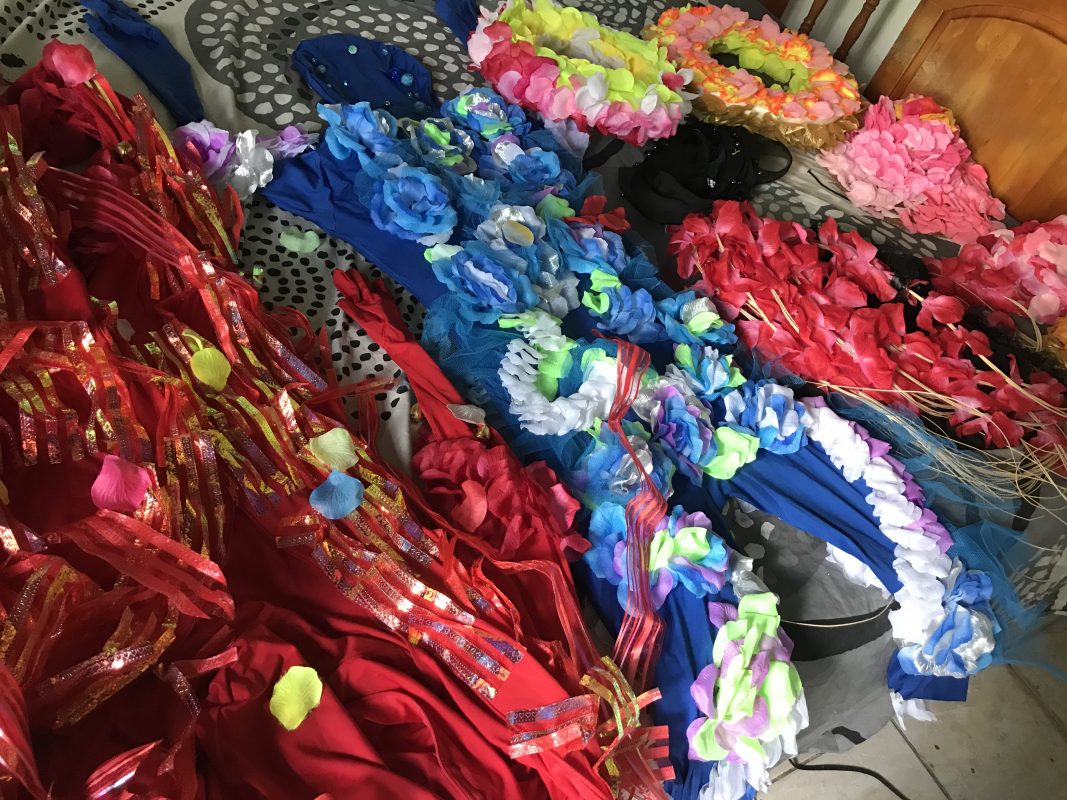
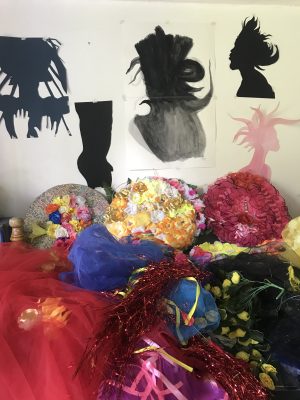
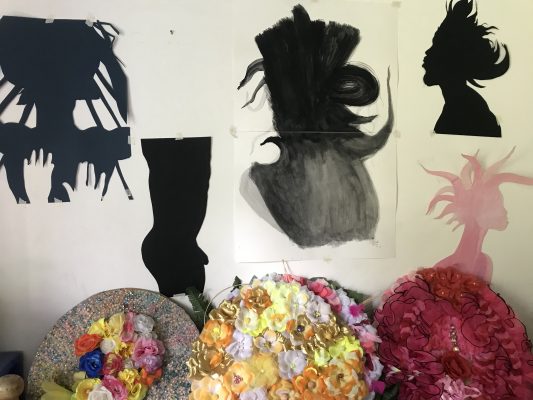
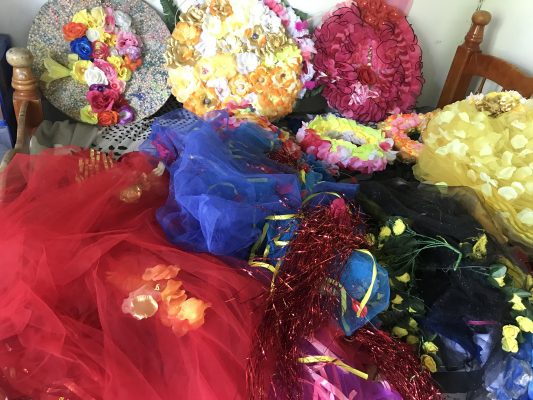
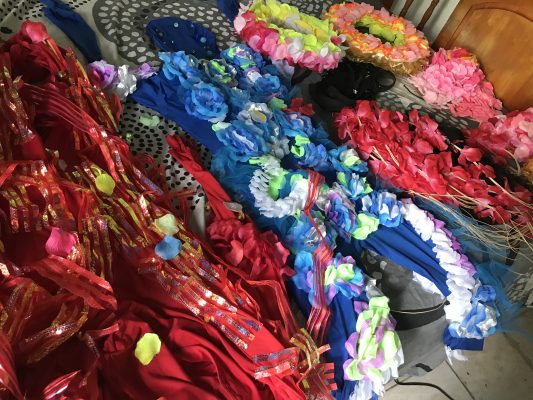
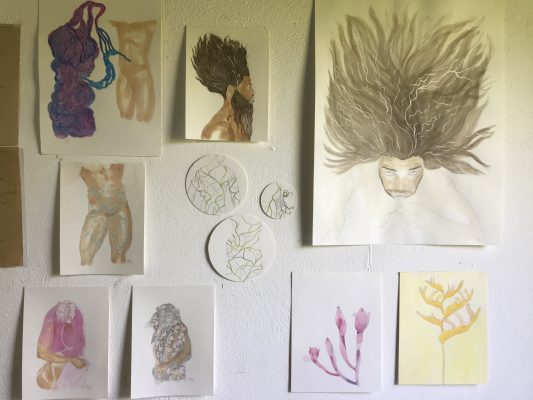
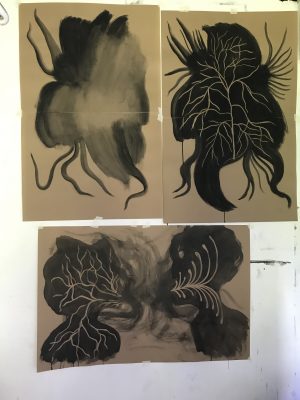
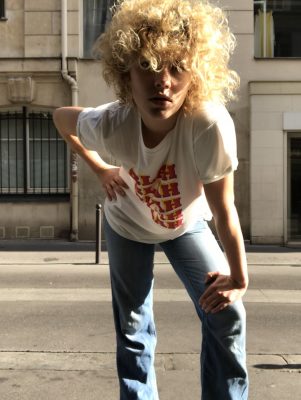
Do you like this artist?
If so, why not write a comment or share it to your social media. Thanks in advance if you can help in this way.